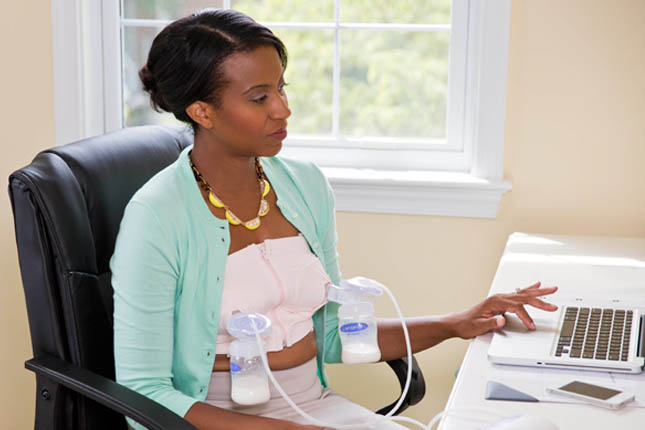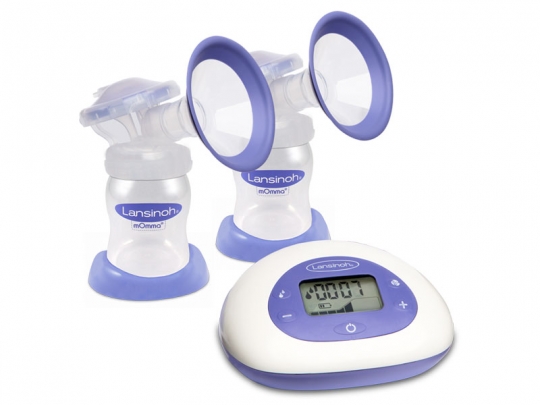The Boob Group
How Pumping Supports Your Breastfeeding Goals
Please be advised, this transcription was performed by a company independent of New Mommy Media, LLC. As such, translation was required which may alter the accuracy of the transcription.
[Theme Music]
LEILANI WILDE: Are you breastfeeding and heading back to work? Do you wonder how to pump to protect your milk supply and still breastfeed? Perhaps you are having difficulties with your baby latching and you need to pump, so your baby can have breast milk. You might be wondering how many minutes you need to pump to sustain your milk supply or maybe even to increase your supply. Today we are talking about how pumping can support your breastfeeding journey and what it takes to protect your milk supply. This is The Boob Group.
[Intro/Theme Music]
LEILANI WILDE: Welcome to the boob group, broadcasting from the Birth Education Center of Santiago. The Boob Group is your weekly, online, on-the-go support group for all things related to breastfeeding. I am your host Leilani Wilde, I am also an IBCLC and owner of Leilani’s Lactation and Doula Services. Thanks for tuning in today, and being a loyal listener of The Boob Group. Don’t forget to visit our website and subscribe to our newsletter for updates on our new episodes. You can stay connected by downloading our free apps available in the Android, iTunes, and Windows Marketplace. Here’s Sunny to tell us more about how you can get involved with our show.
SUNNY GAULT: Alright. Hi, everybody. Thanks for listening to The Boob Group today. We love to hear form our listeners. We love to hear from what you guys have to say and have you guys participate in the show and there’re some different ways you can do that. You may have noticed on the show, we’ve had more and more people call in, which is kind of a program that we are looking to expand a little bit. So, if you are a listener of The Boob Group, and you’re like, “Ah, you know, I don’t live in Santiago where they record. I can’t be part of the show”, guess again. So, we’re reaching out to more and more breastfeeding and pumping mammas via Skype, via phone. So, if you have either of those two resources which, almost, what, almost all of us do, right. We at least have our, you know, we at least have our phone like, in our back pocket.
And so, if you would like to be part of our show, if you would like to join us and talk about some of these great topics we have coming up, we would love to hear from you.So, the best way to do that is to go to our website at www.NewMommyMedia.com . You can click on the panelist section and it will kind of explain the different options. Plus you get to see some of the awesome people that have been panelist on our show in the past. So, that’s a great way. We’re also planning new episode for 2016. So, we would love to hear what your ideas are. We’ve had, let’s say, as of this taping, a hundred and thirty-seven episodes for least. And, so, we would just love to know what breastfeeding and pumping topics are important to you. And we will add those to the line-up. So, if you want to submit for those again you can head on to our website, click on the contact link, and send us an email.
LEILANI WILDE: Great. And today, I’d like to introduce our panelist. Alma, can you tell us a little bit about yourself?
ALMA LOZANO: Yes. Hi, my name is Alma. I’m 21 years old. I’m in the Navy. I’ve one daughter named Olivia and she’s currently eight months old.
LEILANI WILDE: Nice and on the phone today our expert.
GINA CIAGNE: Hi, I’m Gina Ciagne. I’m a Lactation Counselor and I work at Lansinoh laboratory. I am a mom of two formerly breastfed kids. My daughter Jalen is 14 years old and my son Luca is 11 years old.
LEILANI WILDE: Great.
[Theme Music]
SUNNY GAULT: Alright, so, before we kick off today's show, we have a breastfeeding headline. And seems to be having more and more of these types of stories kind of popping up, which I think is somewhat refreshing. So, there is an Australian artist, she’s also a photographer. Her name’s Suzie Blake and she has kind of started this, this thing on and I believe it’s Facebook, I think she posted it to Facebook, yes, where she was thinking about a lot of the images we see in the media when it comes to breastfeeding. We see, recently we talked about it on The Boob Group, but like when Gisele posted that gorgeous photo of her breastfeeding, I think it was Instagram. We’ve see other moms do some similar things, and they have a tendency to be, you know very glamorous. And so this photographer was kind of thinking about that and her own life, and as a breastfeeding mom, and she’s kind of thinking, “You know, it doesn’t really look like that in my house.
So, she took a picture of herself breastfeeding and uploaded it to Facebook and basically tagged it with a line that said, “Hey, if any other breastfeeding mothers out there want me to take photographs of them”, obviously will have to be some sort of proximity to where she lives. But, “if you want me to take photos of you in this manner”, where it’s a very relaxed, just in your home doing what you normally do in your day-to-day lives, she would be happy to do that, and she is putting it in what she’s calling a ‘photo series’ called “what does breastfeeding look like?”.
And, so, I have to read this little paragraph that she wrote, which kind of explains why she’s doing this. She says, “While I sat on the sofa at 3am breastfeeding my son, with the scent of puke on my shoulder while there was gigantic pile of laundry to do and my toddler would be awake in a few hours, I thought, do other women look like I do now? Do other women feel like I do now? Because quite frankly I look and feel pretty awful. So, she just took that, and kind of ran with it and I passed around some photos here in the studio, I’ll make sure they post them on our Facebook page so that you guys can see, but what, what are your thoughts? These are very, you would see these images of, of,you know, moms just in their homes just kind of doing what they are doing, toddlers are running around, it’s, you know, and it’s not that they necessarily have this magical look on their face, either, like, “Oh, despite all the craziness in my life, I’m just, I’m here with my baby and it sounds fantastic”. It’s not even necessarily that. So, anyways, Leilani what’s your take?
LEILANI WILDE: You know, it’s just reality, right? We all as moms experienced what’s it like, day in and day out breastfeeding and it’s normalizing once again.
SUNNY GAULT: Right
LEILANI WILDE: All about normalizing. We make it such a big deal, because, you know, in, in our culture, we fantasize about the whole breast and women’s body and all that, but, you know, our bodies are natural and we breastfeed naturally and it’s, I don’t know, we make such a big deal out of it and it, it should just be normal. I don’t know, I love it though, I breastfeed all four of mine and I can relate to exactly what she’s said.
SUNNY GAULT: Right.
LEILANI WILDE: Yeah, puke on my shoulder, oh yeah.
SUNNY GAULT: Or, it’s called breast milk
LEILANI WILDE: Oh, yeah.
SUNNY GAULT: Or whatever it may be, instead of breast milk, right?
LEILANI WILDE: Oh, yeah, absolutely.
SUNNY GAULT: Alma, what do you think?
ALMA LOZANO: Yeah, well you wake up three O’clock in the morning and you have your oversize T-shirt on and everything and you just feel like crap.
SUNNY GAULT: Gina, I know, you don’t, you can’t see the photos here in the studio, but what do you think of the concept of you know, showing, you know, more average type photos of moms, just doing their day-to-day, you know, things that they do in their home, you know? Do you think that can help the breastfeeding cause, to normalize breastfeeding?
GINA CIAGNE: Oh, yeah, I mean, I think anytime we’re idealizing something, it makes it seem like it’s, you know, abnormal to be doing it. So, I do think that it’s a reality to, you know, be wearing your sweats around or whatever, whatever breastfeeding means to you. Whether you want to like get, get it up, or whether you want to just, you know, roll a bed in that, what the reality is for so many moms, and so many parents. So, I think you know anything that can show that it’s not in its idealized glossy life; I think it’s really important.
SUNNY GAULT: Yeah. And I know that this artist, the photographer is trying to raise some money now, I think via Indiegogo, they have something up there right now, where she wants to kind of, bring this campaign moreover to the US, coz again, this is an Australian artist. So, yeah, so, we’ll see where this, where this goes. My only concern with this though is, if we get so real, not that we shouldn’t be real about breastfeeding, but at what point do we discourage moms you know, in, in their minds of, of young, you know, moms, that maybe, or maybe they are not even mom yet, but people, that, you know, could breastfeed at some point. You know could it have the reverse effect, were like, “Oh, if you breastfeed, you are going to look like that, oh, I don’t, you know, I’m fashionable, I’m this, I don’t want to look anything but”. Do you think it could have the reverse effect?
LEILANI WILDE: No, I don’t think so. I think that you know, how many times do we look at magazines that have the models on there and think, “Oh, Gosh, you know, when I grow up that’s what I’m going to look like”. In reality, you know, we all want to look good.
SUNNY GAULT: Right.
LEILANI WILDE: But, reality is we are average people, and we live amongst average people, so why can’t we just be average and acceptable and normal, like everyone else in every culture?
SUNNY GAULT: Right, right. Alright guys, we’re going to put the link on our Facebook page and you guys can check it out.
[Theme Music]
LEILANI WILDE: Today on The Boob Group, we’re discussing, how pumping can support your breastfeeding journey. Our expert- Gina Ciagne, Certified Lactation Counselor, mom of two breastfed kids, and Global Vice-president of Health Care Relations at Lansinoh, a breastfeeding and pumping accessory company. Thank you, for joining us Gina and welcome to The Boob Group.
GINA CIAGNE: Thank You.
LEILANI WILDE: Gina, why would a breastfeeding mom also pump?
GINA CIAGNE: Well, there are a lot of reasons why a mom would be pumping. I mean, the biggest reason is that she and her baby is go- are going to be apart during a feeding. It would be really important for her to pump, so, her body gets the regular stimulation it needs to keep making milk and she also could keep that milk for future time when she and her baby are going to be apart. But one other thing to understand is that, you know, pumping is not feeding at the breast and vice versa. So, it’s really important for breastfeeding to be established if possible, you know, again, talking about ideal situation, you know, ideally, the baby would be teaching moms body how much milk to make and she would hold up on pumping because essentially is tricking your body into thinking it’s the baby, so, you know, it lets the milk out. So, one of the biggest things is to have milk to leave behind when you are apart. Another reason why a mom would be pumping is that she does need to boost her supply. If she has a little supply, if she [inaudible] she can use pumping to add additional stimulation so she can, you know, store more milk or, or boost her supply.
LEILANI WILDE: Okay. So, really not every mom has to pump, right? I mean, we think about all the other cultures out there, and they don’t have pumps. Maybe they hand express if they need to or something like that, but not, do you believe that every mom needs to know how to pump or is it only if necessary.?
GINA CIAGNE: I really, honestly, I think it’s only if necessary. But, really what’s ending up happening, you know, it’s happened at the last, you know decade or so. It’s so good because so because so many more moms are breastfeeding, more moms are saying I’m going to go back to work and pump and, still if they are breastfeeding. That’s all came really possible with tools like pump. But I don’t think every mom needs to pump. I mean, really the best way to get, to keep your supply to make sure you baby is getting the nutrients that they need to you know, reap all those health benefits for baby and for mom, really is having baby at the breast. But, you know, it’s a, it’s a very overwhelming experience sometimes. Moms are really tired, you’ve got family members that are saying, “I want to feed the baby”. All that’s understandable, but it’s really important to remember that this is a natural thing, and really the baby is the best teacher for telling mom’s body how much milk to make.
LEILANI WILDE: Right, right. I agree with that one. Are there different types of pumps to choose from, depending upon why the mom is pumping?
GINA CIAGNE: Yes, so, obviously, I mean you mentioned it. We have, we have hands and we can hand express. I mean, we don’t have to use a machine or a manual pump. And, you know, many moms do hand express. If you are going to be away, you know, for a sustained period of time, you may be, you know, could use the manual pump. You know, the manual pump works on your power, so you control the, you know the speed and the settings, really of a manual pump. And that’s going to be something that, you know, you just need to pump a little bit out. You, you start making a store of the milk that you pump with a manual pump. But, if a mom is going to be away for several feedings at a time, let’s say, she is going back to work, full time or even part-time, if she’s going to be away for any feeding it’s really, you know, good for her to keep her supply up and to keep that suction and that stimulation going, and so, an electric pump may be a better option for her. The other thing is that, with a manual pump is that you’re doing it one breast at a time. I mean, if you’ve only got a certain amount of time, efficiency-wise doing a double pumping would be more efficient and helps stimulate even more.
LEILANI WILDE: Right. And then there are of course hospital-grade pumps for those in real need in the beginning, right?
GINA CIAGNE: Right. So, if you can’t- if the baby isn’t at the breast right away or the baby, you know, is born prematurely, or before their due date, you know, they may have some sucking, coordination issues and that’s okay, all of that can be resolved, but mom’s body does need to get that stimulation in order to her mature milk to come in. So, a multi-user pump that you can rent from the hospital, you use right there at the hospital is going to help establish the milk your supply.
LEILANI WILDE: And, then moms kind of need to know that there is a really, a big difference between the hospital-grade versus the one that you can purchase yourself, right?
GINA CIAGNE: Well, I mean, there has been a lot of advantage with breast pumps. And one of the biggest differences between the hospital version and retail pump is that the pump you would find at the store you cannot share. It’s a single-user product and that’s regulated by the FDA and, so, and really it depends on the speed and the suction of that pump. Some pumps that are sold in-store aren’t powerful enough really to establish the supply. There are other pumps that are as powerful but are not meant to be shared. So, that’s why the hospital pump is good because it has definitely got good power and is very efficient and it can be used with multiple users and they just have their own separate collection kits.
LEILANI WILDE: Okay. And then, so, the moms that don’t need a hospital-grade pump, can they get it through their insurance?
GINA CIAGNE: Yes, so this is part of the Affordable Care Act. All insurance companies are offering breastfeeding supplies, mainly breast pumps. Some insurance companies are selling breastfeeding accessories as well. But, it really does depend on the insurance company, it just depends on the mom’s coverage, you know, what pump that insurance company is offering. So, those are things that moms can ask when they call their insurance company. You know, what type of pump is covered? When can I get that pump? Because sometimes the insurance companies are saying, you have to wait till after birth, and then some companies are saying you can get it before the birth. So, it’s just good to know, you know, what your insurance coverage is and the type of pumps, some providers only have, you know, one option, some have two, some have three. So, it’s good to know if you have an option and researching pumps is really important. You know, read reviews, you know, see what other people’s experiences have been and then you can actually talk with your insurance about which brand they would be offering.
LEILANI WILDE: Okay, great. Alma, how did you choose your pump?
ALMA LOZANO: I work at a hospital, right. So, they recommended the double electric pump. So, I bought the double electric pump. My insurance started covering it just recently.
LEILANI WILDE: Okay, good. How did you get your insurance to cover? Did you have any specific questions that you had to ask?
ALMA LOZANO: The doctor put the order in and then they called me within the next two days, maybe. And they just asked me if I wanted the double or the single and ofcourse I said the double.
GINA CIAGNE: Yeah, make it easy.
LEILANI WILDE: So, Gina when should a mom start pumping to prepare to go back to work, if that is the reason why she’s pumping.
GINA CIAGNE: Well, I mean, it does depend on how long her maternity leave is, but ideally we’d want to let a mom and baby, you know, sort of establish her milk supply- the two of them. So, we really don’t recommend pumping before four weeks, if possible, again, every mom’s situation is different, and she is not doing anything bad if she pumps beforehand. Again a pump is tricking your body into thinking it’s the baby. So, sometimes moms start pumping earlier on and then they get worried because they are only pumping, let’s say, two, two ounces out. And they think, “Oh, no, that means that’s all my baby is getting. My baby must not be getting enough. I must have a little milk supply”, it all kinds of spirals from there. Whereas the baby at the breast is really efficient and the baby, you know, you could pump two ounces and the baby could get four out. So, it’s really important for baby to be teaching the mom’s body, how much milk to make in that first month so that it’s established.
Then introducing pumping is totally understandable. It’s a good thing to do, especially if you know you are going back to work. So, familiarizing yourself with the pump, getting all the parts out, you know, sterilizing that according to the instructions. You know, I talked to some moms and they just were petrified at getting the pump out of the box and waited until, you know, the day before and then were really worried because their body wasn’t responding and the body just needs a little bit of time. So, you don’t want to wait too long, but you don’t want to go, you know, start too early.
LEILANI WILDE: After moms wonder how soon they should start pumping to prepare to go back to work, maybe just a few days prior to or maybe as long as a week prior to going back to work, they can add an extra pump in the morning after their first-morning feed, when their volume is at their highest. Then they can build up a small supply for when they go back to work. Because their first day they go back to work, they are going to be pumping in exchange for breastfeeding. So, whatever they pump at that first day, they are going to give that baby the milk the second day. And, so, it’s going to stay as fresh and age-relevant as possible so that baby is beast protected. So, Alma, when did you start pumping and how much did you start before you went back to work?
ALMA LOZANO: So, I had to go back to work, at around six weeks postpartum. So, of course, I was procrastinating. About four days before, I started making a stash, it was a pretty tiny stash actually, I should have worked on that a little earlier.
LEILANI WILDE: How much did you actually, how much were you able to pump when you first started out?
ALMA LOZANO: At first it was a lot, when you first, you have to start breastfeeding, it’s a lot of milk. Every day I’d pump maybe a bag which is about 6-8 ounces.
LEILANI WILDE: Okay, and was that like total amount that you pumped, or is that?
ALMA LOZANO: During a day
LEILANI WILDE: Aha, and how many times did you pump?
ALMA LOZANO: Two-three times.
LEILANI WILDE: Two-three times. So, you got somewhere around what three, two to three ounces per pumping session?
ALMA LOZANO: Yes.
LEILANI WILDE: Okay, and your baby was how old?
ALMA LOZANO: She was six weeks that time, yeah.
LEILANI WILDE: Six week. Okay good, good. Okay, when we come back we will discuss how to choose the right size flange and how long a mom should pump for her pumping session. We’ll be right back.
[Theme Music]
LEILANI WILDE: Welcome back to the show. We are here with Gina Ciagne, Certified Lactation Counselor and Global Vice-president of Health Care Relation at Lansinoh, Gina is there more than one size pump flange to choose from?
GINA CIAGNE: Yes, there are different sizes and every company does it slightly differently. You know, the Lansinoh pump the Electric SignaturePro pump, comes with a 24mm size flange. But, really no nipple size is the same, so it’s important to just take a look at, you know, if you are feeling pinching or you are noticing that your nipple is more than just your nipple is being pulled into the tunnel. It would be a really good idea to have a counsel with a lactation counselor or consultant, to see if you need a smaller size or larger size. And many other companies offer different size flanges and there is also a company that does flange adaptors, which really go from very, very extra small all the way upto much larger sizes. But, it’s important for the flange to fit correctly because you don’t want to be in pain. And you also want to make sure that your milk is able to flow and it’s not being tinched and you are not suffering any damage when you are pumping.
LEILANI WILDE: Right. And, that’s what happens. If they have the wrong size flange they can actually do some breast damage, if it’s too much breast tissue being pulled in.
GINA CIAGNE: Absolutely, yeah.
LEILANI WILDE: And, and maybe, if it’s not the right size they may not be able to remove as much milk as well?
GINA CIAGNE: Right, exactly, I mean anytime you have some kind of even whether it’s an unaffordable feeling or it’spain you tend to tense up. Being tense is not conducive with breastfeeding. You want to kind of relax a little bit and pumping is the same way. So, if it’s causing suction or if it’s pinching or just, just doesn’t feel right, whatever is happening, itjust doesn’t feel right, it’s a good idea to get measured and see if you need to go up or go down the size.
LEILANI WILDE: And, Alma, did you know how to correctly choose the right size flange for yourself?
ALMA LOZANO: Yes, I didn’t feel any pain or anything with the regular 24, so I just ended up using that one.
LEILANI WILDE: Okay, good. Gina can you explain what a pumping session looks like and, when you’re preparing to go back to work?
GINA CIAGNE: Sure, yeah, I mean, the closer mom gets to return to work, she wants to maintain breastfeeding, breastfeeding relationship with her baby and you know, breastfeeders often stick together with the baby, that’s going to help, you know, that extra snuggling is going to help when you go back to work and you think, “how am I going to leave the sweet baby?” But, it also is going to be helping with her body getting used to pumping, I mean, she wants to get used to how her body responds to the pump and a lot of moms ask me how long should a pumping session be. And again, it’s like, I’m so sorry, but, it’s like, we are so different that I could pump in ten minutes when it could take someone else 20 minutes. It just depends on how quickly your body responds and what I tell moms is, “Don’t think there’s going to be a certain amount of time.
If you don’t have, if you are not, you know, hemmed in by a certain schedule, I mean if you only get 15 minutes to pump then pump for 12 minutes, and then you could- three minutes to, to clean things up. So, but, if you don’t have to time them, don’t time them. Just let your body let down,let it, you know let the milk flow you will be able to see the streams of milk coming out. When the milk starts to slow down, the stream starts to slow down, you can gently massage your breasts while you are pumping to encourage more milk to be let out. But, you know, you can feel your breast you can feel it getting softer, and you can tell and usually, that’ll be around you know, 15-20 minutes. But, again there are some days where it took me thirty and some days where it took me ten. So, and, you know, when she goes back to work, she’s going to want to mimic her baby schedule.
I mean, so, if she fed her baby at eight and baby usually feeds every two hours she’ll want to pump at ten. And, so really want to try to mimic that because her body is getting used to that schedule, and also, you know, is looking for the regular stimulation plus her breast are going to be filling with milk, and she’s going to be ready to pump when that time comes around.
LEILANI WILDE: Okay, good, and, what about if a mom wants to pomp just to increase her supply. Is there a particular way to do that?
GINA CIAGNE: Yeah, I mean, there are a lot of different methods to do. It, it’s really important that a mom knows that she really does have a little supply. I think that’s one of the biggest concerns that moms have that they are not going to have enough, they are not going to produce enough, especially for breastfeeding moms who are not feeding you know with a bottle, they can’t, you know, they can’t measure what’s, what’s going in when they are strictly breastfeeding. So, I think it would be important for mom to make sure, that she you know, talk, check in with someone andsee if she does really have a little supply, whether her baby is gaining weight, there’s good enough chance for that.
But as far as pumping to increase her supply there’s something called power-pumping, we have the information up on our website at lansinoh.com and there’s also great resource www.KellyMom.com which is a really great resource, talks about power pumping and it gives you some good you know, parameter as far as you know, feeding the baby and then pumping, pumping, pumping and then taking a break, and then pumping, pumping, pumping and then taking a break, and it’s just, it’s not one of the things that you have to do forever. It just really to sort of kick starts your body into increasing your milk supply.
LEILANI WILDE: Right. Because, you know, we have to go back to the, how our bodies work and our bodies work by demand and when we demand more from our body and our body produces the milk. So, that’s kind of the, the idea behind the power-pumping, right? We’re demanding more.
GINA CIAGNE: Exactly, yup.
LEILANI WILDE: So, how about if a baby is not latching well, let’s say, in the beginning maybe,mom struggling with maybe a tongue-tie or something, like that, and the baby is just not latching well, not moving enough milk. Is there a way she should be pumping to protect her supply?
GINA CIAGNE: Well, I mean, for that- latching baby, and you know, gentle massage before and while she’s nursing can also help push that milk down gently, you know with a gentle massage, so, you know, if baby isn’t able to suck and to latch on and it’s strong enough to wait mom can encourage the milk to come down and baby at the breast is actually still going to be encouraging with that stimulation with baby latching on and then after mom is done nursing, you know, letting the baby nurse one by one and then pumping after that that’s going to get the majority of milk out of the breast and the body again will then replenish the milk.
So, the most important thing is the baby at the breast, that maybe, you know, can be practicing and working on nursing, you know pumping to make sure they are getting the milk out and then also making sure that the baby gets fed. So, if baby isn’t getting what it seems like enough at the breast, obviously you will be having express milk and you can have that given to the baby. I mean that’s really, really important whether it’s tongue tie, whether it’s slip tie, anything like that you need to make sure that the baby is you know, gaining weight and getting the milk, even if there are some issues that we are addressing with the, the latching on.
LEILANI WILDE: Number one thing, feed the baby, right?
GINA CIAGNE: Exactly
LEILANI WILDE: Right, good. Alma what were the reasons that you needed to pump for, other than going back to work, is it, or is that it? I mean, is that your main focus?
ALMA LOZANO: I also did some of the power pumping because I realized I needed more milk.
GINA CIAGNE: Okay.
ALMA LOZANO: So, that is another reason I did it.
LEILANI WILDE: What made you think that you needed more milk?
ALMA LOZANO: I was pumping and I was getting very small amounts, maybe an ounce on one and maybe half an ounce on the other. So, I decided maybe I should power pump.
LEILANI WILDE: Did that help?
ALMA LOZANO: It did, it did help a lot.
LEILANI WILDE: Well, thank you so much Gina and Alma for helping us all better understand how pumping can support your breastfeeding journey. And for our Boob Group club members, our conversation will continue after the end of this show, as Gina, will give us a tip to aid you and comfort when using the pump, if you have severely cracked or bleeding nipples. For more information about our Boob Group Club, please visit our website at www.NewMommyMedia.com
[Theme Music]
SUNNY GAULT: Alright, it is time for our funny segment we have on The Boob Group called The Boob Oops, and it’s where you guys share your funny stories, and I love this one, this is nice and short and it comes from Laura. And Laura says. “My breastfeeding story is funny and cute. I was feeding my younger daughter in a coffee shop. Some people were glaring at me, even though I have a blanket thrown over my shoulder. It made me very uncomfortable and I thought of going to my car. Just then my two-and-a-half-year-old looked over at these very rude people and said, “It’s only Lulu’s milk, stop looking at us please”. I think I have an activist on my hands. Needless to say, they stopped looking and I did not have to go to the car”.
I love this Laura, I can totally picture your little girl saying that, because my little girls are about two and I think that they are getting to the point where someone try to take their milk away from them or gave them a mean look , I really think that they would go after them as well.
So, anyway Laura, thanks so much for sending this and if you guys have a funny Boob Oops story, you want to share with us you can go to our website, click the contact link and submit it that way. Or you can call our voicemail at 619-866-4775.
[Theme Music]
LEILANI WILDE: That wraps up our show for today. We appreciate you listening to The Boob Group.
Don’t forget to check out our sister show:
• Preggie Pals for expecting parents
• Newbies for newly postpartum moms
• Parent Savers for moms and dads with infants and toddlers and
• Twin Talks, for parents of multiples.
Thanks for listening to The Boob Group: “Your judgment-free breastfeeding resource.”
[Disclaimer]
This has been a New Mommy Media production. Information and material contained in this episode are presented for educational purposes only. Statements and opinions expressed in this episode are not necessarily those of New Mommy Media and should not be considered facts. Though such information in which areas are related to be accurate, it is not intended to replace or substitute for professional, medical or advisor care and should not be used for diagnosing or treating health care problem or disease or prescribing any medications. If you have questions or concerns regarding your physical or mental health or the health of your baby, please seek assistance from a qualified health care provider.
SUNNY GAULT: New Mommy Media is expanding our lineup of shows for new and expecting parents.If you have an idea for a new series or if you’re a business or an organization interested in joining our network of shows through a co-branded podcast, visit www.NewMommyMedia.com.
[00:31:24]
[End of Audio]












